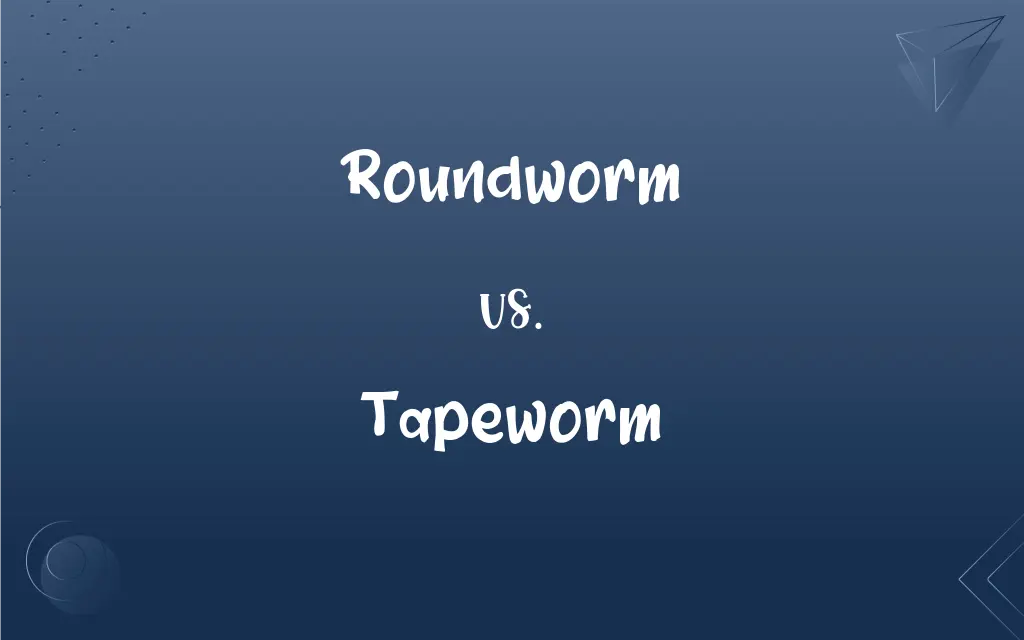Roundworm vs. Tapeworm: What's the Difference?
Edited by Aimie Carlson || By Janet White || Published on January 11, 2024
Roundworms are cylindrical, unsegmented parasites with a digestive system, while tapeworms are flat, segmented, and lack a digestive system.

Key Differences
Roundworms (nematodes) are cylindrical, worm-like parasites that inhabit various environments, including soil and animal intestines. Tapeworms (cestodes) are flat, ribbon-like parasites typically found in the intestines of vertebrates, including humans.
Unlike tapeworms, roundworms possess a complete digestive system with a mouth, gut, and anus. Tapeworms, on the other hand, absorb nutrients directly through their skin, lacking a digestive tract.
Roundworms can cause diseases like ascariasis and trichinosis in humans and animals. Tapeworm infections, such as taeniasis, occur by consuming undercooked meat containing tapeworm larvae.
Reproduction in roundworms involves both male and female individuals, with some species capable of self-fertilization. In contrast, tapeworms have both male and female reproductive organs in each segment and can self-fertilize or cross-fertilize within the same host.
Roundworms are generally smaller in size compared to tapeworms, which can grow several meters in length, depending on the species.
ADVERTISEMENT
Comparison Chart
Shape
Cylindrical and unsegmented
Flat and segmented
Digestive System
Complete (mouth, gut, anus)
Lacks a digestive system
Habitat
Soil, animal intestines
Intestines of vertebrates
Diseases in Humans
Ascariasis, trichinosis
Taeniasis, cysticercosis
Reproductive System
Separate sexes or self-fertilizing
Hermaphroditic in each segment
ADVERTISEMENT
Roundworm and Tapeworm Definitions
Roundworm
Roundworms belong to the phylum Nematoda.
Nematode research has provided insights into roundworm biology.
Tapeworm
Tapeworms belong to the class Cestoda.
The study of Cestoda has advanced our understanding of tapeworm infections.
Roundworm
Roundworms have a complete digestive system.
The roundworm's digestive tract allows it to feed on various organic materials.
Tapeworm
Tapeworms absorb nutrients directly through their body surface.
The tapeworm relies on its host's digested food for sustenance.
Roundworm
Roundworms are cylindrical, parasitic or free-living worms.
The garden soil was found to be infested with roundworms.
Tapeworm
Tapeworms are flat, segmented parasites living in host intestines.
A tapeworm was found during the examination of an infected dog.
Roundworm
Roundworms can be microscopic or visibly elongated.
A roundworm was detected in the patient's intestinal sample.
Tapeworm
Tapeworms can grow several meters long inside a host.
The veterinarian removed a two-meter-long tapeworm from the feline patient.
Roundworm
Roundworms are prevalent in both aquatic and terrestrial ecosystems.
Roundworms contribute to nutrient cycling in many ecosystems.
Tapeworm
Tapeworms have a head with suckers or hooks for attachment.
The tapeworm's head was firmly anchored to the host's intestinal wall.
Roundworm
See nematode.
Tapeworm
Any of various long segmented parasitic flatworms of the class Cestoda that lack a digestive system and have hooks or suckers for attaching to the intestines of vertebrates, including humans. Also called cestode.
Roundworm
An invertebrate animal of the phylum Nematoda and other similar phyla. Many species of roundworms are parasites.
Tapeworm
(countable) Any parasitical worm of the class or infraclass Cestoda, which infest the intestines of animals, including humans, often infecting different host species during their life cycle.
Roundworm
A nematoid worm.
Tapeworm
(countable) A broad fish tapeworm, Diphyllobothrium latum.
Roundworm
Infections of the skin or nails caused by fungi and appearing as itching circular patches
Tapeworm
(uncountable) Infection by tapeworms.
Roundworm
Unsegmented worms with elongated rounded body pointed at both ends; mostly free-living but some are parasitic
Tapeworm
Any one of numerous species of cestode worms belonging to Tænia and many allied genera. The body is long, flat, and composed of numerous segments or proglottids varying in shape, those toward the end of the body being much larger and longer than the anterior ones, and containing the fully developed sexual organs. The head is small, destitute of a mouth, but furnished with two or more suckers (which vary greatly in shape in different genera), and sometimes, also, with hooks for adhesion to the walls of the intestines of the animals in which they are parasitic. The larvæ (see Cysticercus) live in the flesh of various creatures, and when swallowed by another animal of the right species develop into the mature tapeworm in its intestine. See Illustration in Appendix.
Tapeworm
Ribbon-like flatworms that are parasitic in the intestines of humans and other vertebrates
FAQs
What are roundworms?
Parasitic or free-living worms with a cylindrical shape.
How do humans get tapeworms?
By consuming undercooked meat with tapeworm larvae.
Do roundworms have a digestive system?
Yes, a complete one with mouth, gut, and anus.
Are roundworm infections common?
Yes, particularly in areas with poor sanitation.
How do roundworms infect humans?
Through contaminated soil, water, or infected food.
Do tapeworms have a digestive system?
No, they absorb nutrients through their skin.
What are tapeworms?
Flat, segmented parasites living in the intestines of vertebrates.
How long can tapeworms grow?
Up to several meters in a host's intestines.
Can roundworms be seen with the naked eye?
Some species can, others are microscopic.
Can you prevent tapeworm infections?
Yes, by cooking meat thoroughly and practicing good hygiene.
What symptoms do tapeworm infections cause?
Often mild, but can include abdominal pain and weight loss.
Are roundworms dangerous?
They can be, particularly if they invade body tissues.
Is there a cure for tapeworm infections?
Yes, typically with prescribed antiparasitic drugs.
What animals are commonly affected by roundworms?
Many, including dogs, cats, and livestock.
How do roundworms reproduce?
Through eggs, with separate sexes or self-fertilization.
What's the lifespan of a tapeworm in a host?
It can be many years, depending on the species and conditions.
How do tapeworms reproduce?
Each segment has both male and female organs for reproduction.
Can roundworms affect plants?
Yes, some species are known plant parasites.
Can roundworm infections be treated?
Yes, with antiparasitic medications.
Can tapeworms be transmitted between humans?
Not directly, transmission requires an intermediate host.
About Author
Written by
Janet WhiteJanet White has been an esteemed writer and blogger for Difference Wiki. Holding a Master's degree in Science and Medical Journalism from the prestigious Boston University, she has consistently demonstrated her expertise and passion for her field. When she's not immersed in her work, Janet relishes her time exercising, delving into a good book, and cherishing moments with friends and family.
Edited by
Aimie CarlsonAimie Carlson, holding a master's degree in English literature, is a fervent English language enthusiast. She lends her writing talents to Difference Wiki, a prominent website that specializes in comparisons, offering readers insightful analyses that both captivate and inform.































































